mybatis-plus
1. Introduction case:
Table creation:
create table user
(
id bigint auto_increment comment 'Primary key ID'
primary key,
name varchar(30) null comment 'full name',
age int null comment 'Age',
email varchar(50) null comment 'mailbox',
create_time datetime null comment 'Creation time',
update_time datetime null comment 'Modification time',
version int default 1 null comment 'Optimistic lock',
deleted int(1) default 0 null comment 'Logical deletion'
)
charset = utf8;
1.1 create a springboot project:

1.2 import dependency:
<dependencies>
<dependency>
<groupId>org.springframework.boot</groupId>
<artifactId>spring-boot-starter-web</artifactId>
</dependency>
<dependency>
<groupId>org.springframework.boot</groupId>
<artifactId>spring-boot-devtools</artifactId>
<scope>runtime</scope>
<optional>true</optional>
</dependency>
<dependency>
<groupId>org.springframework.boot</groupId>
<artifactId>spring-boot-starter-test</artifactId>
<scope>test</scope>
</dependency>
<dependency>
<!-- Database driven-->
<groupId>mysql</groupId>
<artifactId>mysql-connector-java</artifactId>
</dependency>
<dependency>
<groupId>org.projectlombok</groupId>
<artifactId>lombok</artifactId>
</dependency>
<!-- mybatis-plus-->
<dependency>
<groupId>com.baomidou</groupId>
<artifactId>mybatis-plus-boot-starter</artifactId>
<version>3.0.5</version>
</dependency>
<dependency>
<groupId>junit</groupId>
<artifactId>junit</artifactId>
<scope>test</scope>
</dependency>
</dependencies>
1. 3. Write configuration file: application Properties or application yaml
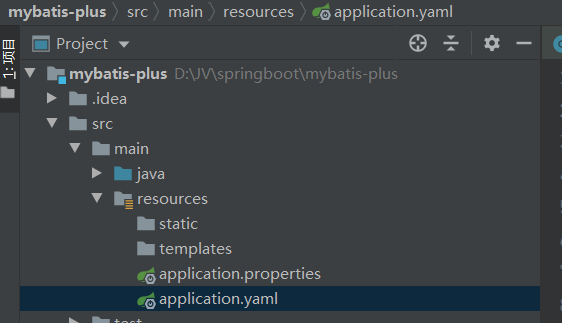
#Database link configuration
spring:
datasource:
username: user name
password: password
url: jdbc:mysql://localhost:3306 / database description? useSSL=false&useUnicode=true&characterEncoding=utf8&serverTimezone=GMT%2B8
driver-class-name: com.mysql.cj.jdbc.Driver
#Log configuration
mybatis-plus:
configuration:
log-impl: org.apache.ibatis.logging.stdout.StdOutImpl
#Logical delete configuration
global-config:
db-config:
logic-delete-field: deleted
logic-delete-value: 1
logic-not-delete-value: 0
2. Coding:
Class, package structure:
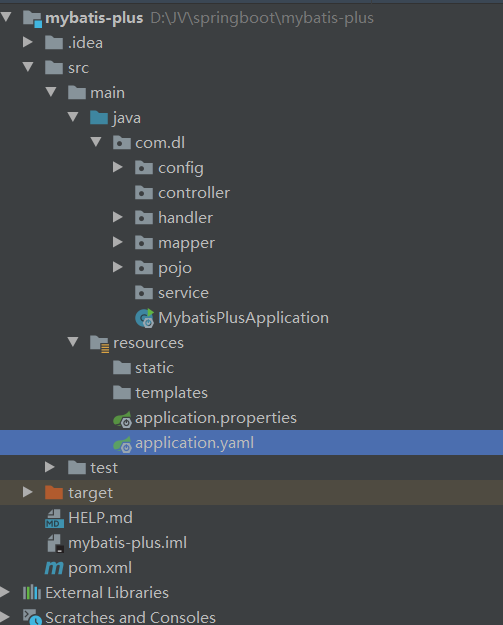
2.1 pojo entity class preparation:
/**
* @ClassName User
* @Description TODO
* @Author 86188
* @DAte 2021/11/17
**/
@Data
@AllArgsConstructor
@NoArgsConstructor
public class User {
@TableId(type = IdType.AUTO)//Automatic growth
private Long id;
private String name;
private Integer age ;
private String email;
@TableLogic//Delete annotation logically
private Integer deleted; //Logical deletion
@Version //Optimistic lock annotation
private Integer version;
@TableField(fill = FieldFill.INSERT)//When is the insert updated
private Date createTime;
@TableField(fill = FieldFill.INSERT_UPDATE)//Update when update
private Date updateTime;
}
2.2 mapper interface (userMapper):
/**
* @ClassName UserMapper
* @Description TODO
* @Author 86188
* @DAte 2021/11/17
**/
@Mapper
public interface UserMapper extends BaseMapper<User> {
}
Note: annotate @ mapper annotation
Inherit basemapper < >

2.3 test:
@SpringBootTest
class MybatisPlusApplicationTests {
@Autowired
private UserMapper userMapper;
@Test
void contextLoads () {
List<User> userList = userMapper.selectList (null);
for (User user : userList) {
System.out.println ("user = " + user);
}
}
}
Test results:

**Log configuration:
#Log configuration
mybatis-plus:
configuration:
log-impl: org.apache.ibatis.logging.stdout.StdOutImpl
2.4 adding: (userMapper.insert())
//insert
@Test
public void testInsert(){
User user = new User (null, "Sark", 23, "dsafrwr@qq.com",null,null,null,null);
int insert = userMapper.insert (user);
System.out.println (user);
System.out.println (insert);
}
Test results: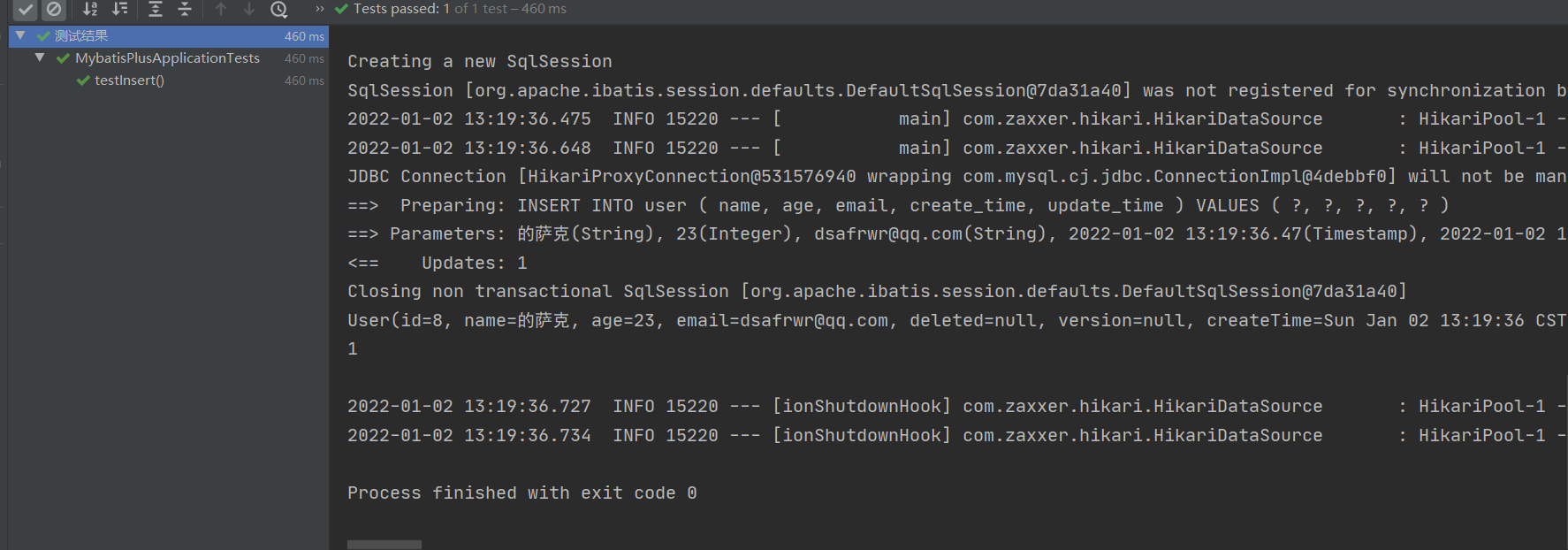
3. Primary key generation strategy:
3.1. Automatic growth: (Auto_increment)
@TableId(type = IdType.AUTO)//Automatic growth
private Long id;
3.2 uuid: (unique value of production random):
@TableId(type = IdType.ASSIGN_UUID)//uuid
private Long id;
3.3 mybatis plus built-in policy (snowflake algorithm) (also the default):
The ID generated by snowflake algorithm is a 64 bit long number and increases with time trend. It is roughly composed of four parts: first invalid character, timestamp difference, machine code and serial number.

As shown in the figure:
- First invalid symbol: the first bit is used as the symbol bit. Because we generate positive numbers, the first bit is uniformly 0.
- Timestamp: 41 bit, accurate to milliseconds. 41 bits can best represent 2 ^ 41-1 milliseconds, which is converted into 69 years.
- Machine code: it occupies 10 bits, of which the upper 5 bits are the data center ID and the lower 5 bits are the working node ID, which can accommodate 1024 nodes at most.
- Serial number: it takes up 12 bits. Each node starts accumulating every millisecond from 0. It can be accumulated to 4095 at most. A total of 4096 ID S can be generated.
@TableId(type = IdType.NONE)//
private Long id;
4. Implement the update operation:
@Test //modify
public void updateTest(){
User user = new User ();
user.setAge (24);
user.setId (7L);
userMapper.updateById (user);
System.out.println (user);
}
5. Auto fill:
5.1 create_time and update_time
@TableField(fill = FieldFill.INSERT)//When is the insert updated
private Date createTime;
@TableField(fill = FieldFill.INSERT_UPDATE)//Update when update
private Date updateTime;
5.2 MyMateObjectHandler configuration
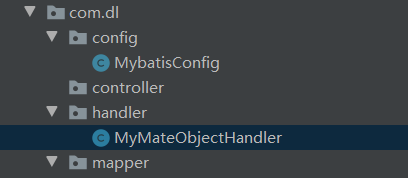
@Component
public class MyMateObjectHandler implements MetaObjectHandler {
//Execute when insert ing
@Override
public void insertFill ( MetaObject metaObject ) {
this.setFieldValByName ("createTime",new Date (),metaObject);
this.setFieldValByName ("updateTime",new Date (),metaObject);
}
//When is update executed
@Override
public void updateFill ( MetaObject metaObject ) {
this.setFieldValByName ("updateTime",new Date (),metaObject);
}
}
6. Optimistic lock (parallel operation):
Optimistic lock is used to solve dirty reading and unreal reading in case of thread conflict. Optimistic lock is produced to solve this problem; Optimistic lock thinks that there will be no data conflict by default, so it will formally detect whether the data conflict occurs when the data is submitted for update. If a conflict is found, it will return an error message to the user to let the user decide how to do it.
Use the version number to control. If a person changes the value, the version number + 1. As long as the version number is different, the operation cannot succeed.
6.1 . Add the @ Version annotation to the field of the entity class
@Version //Optimistic lock annotation
@TableField(fill = FieldFill.INSERT)//Update on insert
private Integer version;
6.2 write configuration class:
1. The default value is 1 when adding;
@Component
public class MyMateObjectHandler implements MetaObjectHandler {
//Execute when insert ing
@Override
public void insertFill ( MetaObject metaObject ) {
this.setFieldValByName ("createTime",new Date (),metaObject);
this.setFieldValByName ("updateTime",new Date (),metaObject);
//Default value of insert: version=1
this.setFieldValByName ("version",1,metaObject);
}
2. Configure optimistic lock plug-in:
@EnableTransactionManagement //Automatically manage transactions
@Configuration
@MapperScan("Modify as needed")
public class MybatisPlusConfig {
/**
* Old edition
*/
@Bean
public OptimisticLockerInterceptor optimisticLockerInterceptor() {
return new OptimisticLockerInterceptor();
}
/**
* new edition
*/
@Bean
public MybatisPlusInterceptor mybatisPlusInterceptor() {
MybatisPlusInterceptor mybatisPlusInterceptor = new MybatisPlusInterceptor();
mybatisPlusInterceptor.addInnerInterceptor(new OptimisticLockerInnerInterceptor());
return mybatisPlusInterceptor;
}
}
7. Paging query:
7.1 paging configuration:
@EnableTransactionManagement //Automatically manage transactions
@Configuration
public class MybatisConfig {
@Bean
public MybatisPlusInterceptor mybatisPlusInterceptor () {
MybatisPlusInterceptor interceptor = new MybatisPlusInterceptor();
//Optimistic lock configuration plug-in optisticlockerinnerinterceptor
interceptor.addInnerInterceptor(new OptimisticLockerInnerInterceptor());
// Latest PaginationInnerInterceptor
interceptor.addInnerInterceptor (new PaginationInnerInterceptor (DbType.H2));
return interceptor;
}
}
7.2 test:
//paging
@Test
public void testPage(){
//Parameter 1: current page parameter 2: page size
Page<User> page = new Page<> (1,5);
// page.getPages ();// Get total pages
// page.getCurrent ();// Get current page
// long size = page.getSize ();// Number of live pages
Page<User> userPage = userMapper.selectPage (page, null);
long pages = userPage.getPages ();
for (User record : page.getRecords ()) {
System.out.println (record);
}
System.out.println (pages);
// System.out.println (size);
}
8. Logical deletion:
- Logical deletion: false deletion, but can't be found later
- Physical deletion: really delete the data in the table
//delete physical data is directly removed;
@Test
public void testDelete(){
int i = userMapper.deleteById (1461235673628418052L);
}
8.1 add the deleted field;
Some don't need to be added too much;
alter table user add column deleted boolean;
8.2 add @ TableLogic annotation to entity class field
@TableLogic private Integer deleted;
8.3 configuration
Method 1:
mybatis-plus:
global-config:
db-config:
logic-delete-field: deleted # Global logically deleted entity field name (since 3.3.0, it can be ignored after configuration, and step 2 is not configured)
logic-delete-value: 1 # Logical deleted value (default is 1)
logic-not-delete-value: 0 # Logical undeleted value (0 by default)
Method 2: or configure on the configuration class:
@TableLogic private Integer deleted;
Configure in configuration class
/**
* Logical delete plug-in
* @return
*/
@Bean
public ISqlInjector sqlInjector (){
return new LogicSqlInjector ();
}
9.Wrapper:
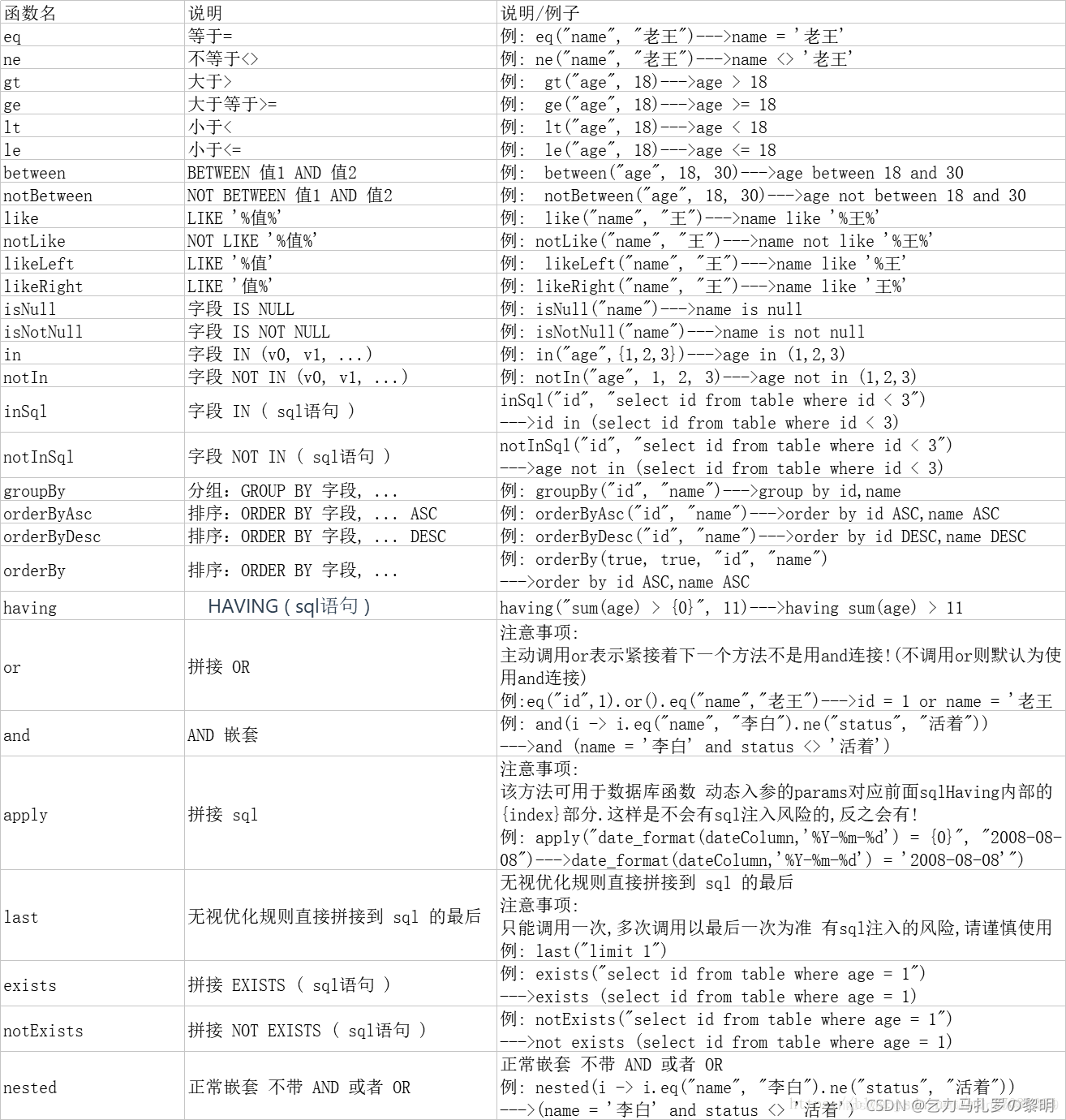
9.1 QueryWrapper
Various methods:
isNotNull Not empty
* ge Greater than or equal to
* gt greater than
* le Less than or equal to
* lt less than
* eq be equal to selectOne
*
* between and
*
* like Fuzzy query %..%
* likeLeft %..
* likeRight ..%
* notLike not %..%
* inSql (age,"select id from user where id > 3")
* age in ("select id from user where id > 3")
*
*
* orderByDesc id Descending sort
@Test
public void test1(){
//The query name is not empty, and the age is less than or equal to 20
QueryWrapper<User> wrapper = new QueryWrapper<> ();
wrapper.isNotNull ("name");
wrapper.le ("age",20);
List<User> list = userMapper.selectList (wrapper);
for (User user : list) {
System.out.println (list);
}
}
9.2 updateWrapper:
@Test
public void testUpdate1() {
//Modify value
User user = new User();
user.setAge(99);
user.setName("Andy");
//modify condition
UpdateWrapper<User> userUpdateWrapper = new UpdateWrapper<>();
userUpdateWrapper
.like("name", "h")
.or()
.between("age", 20, 30);
int result = userMapper.update(user, userUpdateWrapper);
System.out.println(result);
UPDATE user SET name=?, age=?, update_time=? WHERE deleted=0 AND name LIKE ? OR age BETWEEN ? AND ?
10. Code generator:
public class CodeGenerator {
@Test
public void run() {
// 1����������������
AutoGenerator mpg = new AutoGenerator();
// 2��ȫ������
GlobalConfig gc = new GlobalConfig();
String projectPath = System.getProperty("user.dir");
gc.setOutputDir("D:\\JV\\Vaccine management\\project\\" + "/src/main/java"); //Remember to write the absolute path to the position of the birth scale
gc.setAuthor("dl"); //author
gc.setOpen(false); //���ɺ��Ƿ����Դ������
gc.setFileOverride(false); //��������ʱ�ļ��Ƿ�
gc.setServiceName("%sService"); //ȥ��Service�ӿڵ�����ĸI
gc.setIdType(IdType.ID_WORKER_STR); //��������
gc.setDateType(DateType.ONLY_DATE);//�������ɵ�ʵ��������������
gc.setSwagger2(true);//����Swagger2ģʽ
mpg.setGlobalConfig(gc);
// 3������Դ����
DataSourceConfig dsc = new DataSourceConfig();
dsc.setUrl("jdbc:mysql://localhost:3306/yimiao?serverTimezone=GMT%2B8 "); / / database link url
dsc.setDriverName("com.mysql.cj.jdbc.Driver"); //driver
dsc.setUsername(""); //Database name root
dsc.setPassword(""); // Database password
dsc.setDbType(DbType.MYSQL);
mpg.setDataSource(dsc);
// 4��������
PackageConfig pc = new PackageConfig();
pc.setModuleName("app"); //ģ����
pc.setParent("com.dl"); //Package name
pc.setController("controller");
pc.setEntity("entity");
pc.setService("service");
pc.setMapper("mapper");
mpg.setPackageInfo(pc);
// 5����������
StrategyConfig strategy = new StrategyConfig();
strategy.setInclude("address","administrators","appointment","logs","users","vaccines"); //The name of each table in the database
strategy.setNaming(NamingStrategy.underline_to_camel);//��� ݿ �� ӳ And ʵ �����������
strategy.setTablePrefix(pc.getModuleName() + "_"); //����ʵ��ʱȥ����ǰ
strategy.setColumnNaming(NamingStrategy.underline_to_camel);//��� ݿ ��� ֶ � ӳ And ʵ �����������
strategy.setEntityLombokModel(true); // lombok ģ�� @Accessors(chain = true) setter��ʽ����
strategy.setRestControllerStyle(true); //restful api��������
strategy.setControllerMappingHyphenStyle(true); //url���շ�ת���ַ�
mpg.setStrategy(strategy);
// 6��ִ��
mpg.execute();
}
}
last:
Remember to pay attention!